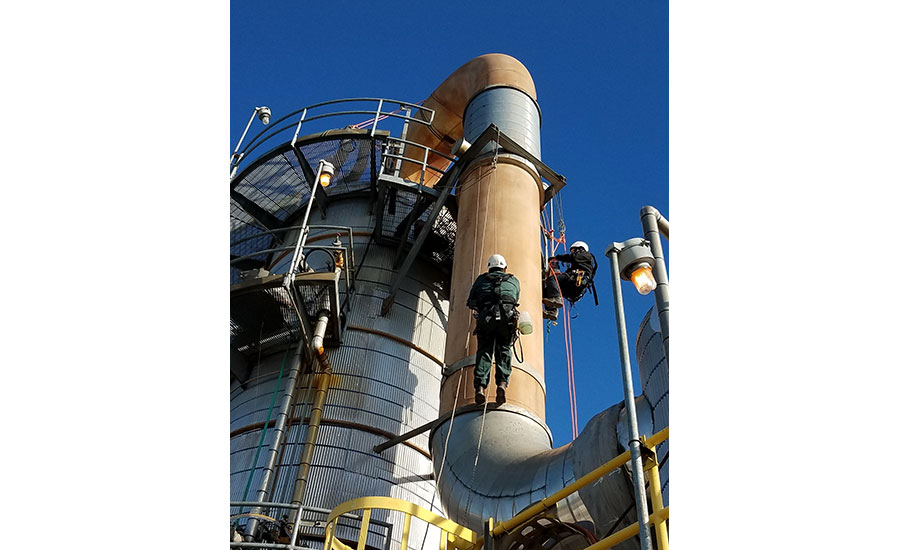Asking a team of skilled craft workers to hang hundreds of feet in the air by rope may not sound like the safest routine maintenance option for your company. But that’s exactly what using a rope access team can offer.
A rope access team deploys highly trained technicians who use ropes moored by a series of secure anchor points to ascend upward of 200 feet in the air. Once in the air, these technicians perform a variety of skilled crafts including pipefitting, boilermaking, insulation, welding and ironwork.
Rope access can be a safe, efficient and cost-effective option compared to traditional scaffolding. Using rope access can help minimize risk by reducing required manhours for scaffolding construction and teardown, and it can lower costs by eliminating the use of scaffolding materials. Rope access technicians must also undergo rigorous safety training, which increases their awareness on the jobsite.
While rope access has its advantages, it takes an incredible amount of time and effort to establish a crew and to ensure their work will be efficient, effective and, most importantly, safe. Here are some focus areas to ensure a solution for your rope access success.
Safety First
As with any aspect of a job, safety must be the number one priority. Project managers who are performing planning and risk assessments must determine whether or not rope access is a safe and viable option for a site.
The Society of Professional Rope Access Technicians (SPRAT), a well-respected training and regulation organization for rope access in the U.S., requires an access work plan to be completed before beginning rope access work. That plan should include provisions for providing secure rope anchor locations, an accident response plan, and a risk assessment that identifies all hazards and outlines solutions to mitigate them, among other things.
For example, if technicians cannot find enough secure anchor points to tie off the ropes, or if technicians cannot work out a proper rescue plan based on the location of the job, then traditional scaffolding may make more sense.
Rope access cannot and should not be forced upon every site. If safety can be assured, then your team can reach new heights.
It’s About Time
Aspiring rope access technicians can’t expect to step on a site and wing it. They have to log plenty of rope time before they can get to work.
To be certified as a Level I technician by SPRAT, a worker must undergo 40 hours of classroom time, then be assessed on a jobsite by a third-party evaluator. To reach Level II, a technician has to put in 500 verified hours of rope time on a jobsite, which can take up to a year. Level III requires an additional 500 hours. The Industrial Rope Access Trade Association (IRATA), an international rope access governing body, requires 1,000 hours logged to reach Level II and another 1,000 hours for Level III, along with first aid training.
Logging all these hours doesn’t happen overnight. Companies interested in establishing a rope access division must be ready and willing to put in the hours to train technicians for success.
Steady As She Grows
The use of rope access has grown at a remarkable rate worldwide. IRATA announced in March that its membership had surpassed 500 companies, up from less than 200 in 2010 and less than 100 in 2005. That’s no surprise considering the cost savings it can provide.
At one facility, Turner Industries saved its client more than $500,000 in the first quarter of 2019 through mechanical rope access. Long-term goals for the client include saving about $10 million annually in routine maintenance costs. At another facility, Turner Industries helped a client save more than $3 million in 2018 through the use of a nondestructive examination rope access team.
With those kinds of results it’s natural for clients to ask you to expand your rope access team rapidly to work on a multitude of projects. It’s tempting to meet that demand quickly, but it’s also prudent to manage client expectations.
Growth must be sustainable. While using rope access can reduce manhours and lower costs, demand cannot outpace the available workforce. Companies must take time to identify workers who will make for great rope access technicians—and those technicians must be trained to reach SPRAT or IRATA certification. In addition, rope access teams have to be managed by a Level III-certified technician, and it can take a technician about three years to reach that status.
Like with any job, continued rope access success relies upon a balanced approach that includes keeping an eye on steady future growth while ensuring that safety and skill are paramount. Without a proper approach, your rope access team—and your clients—could be left grounded.
Tweets by TurnerInd


Post a comment to this article
Report Abusive Comment